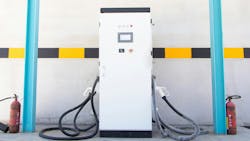Ensuring the future of EV charging in California is policy-proof
In this story, you'll learn about:
- How charging infrastructure reliability is a barrier to wider EV adoption
- The need for EV charging infrastructure maintenance
- Current programs and tools to help upkeep vehicle chargers
California leads the nation in electric vehicle (EV) adoption, and in the summer of 2024, it received $380 million from the Bipartisan Infrastructure Law to boost its efforts to expand and maintain its EV charging infrastructure. However, additional support will not be guaranteed in coming years, despite the job being far from complete.
Although California has the highest number of charging stations in the country, reaching 150,000 public chargers, the state ranks 49th out of 50 regarding charger availability, with just one public port for every 29 EVs. For Californians, this means that finding and using a working charger is becoming increasingly difficult, highlighting a pressing issue: the reliability of existing EV charging stations.
Improving charger reliability while recognizing the uncertainty of future policy support will require rapid, targeted investment in maintaining and optimizing the chargers that are already being deployed. A pivotal aspect of accomplishing this will be the training and equipment of a vast EVSE technician workforce that can help develop and maintain the infrastructure to support the state’s EV revolution.
Bridging the gap between expansion and reliability
In 2024, California, a long-time pioneer in EV rebates and other incentives, was tasked with installing 1 million new chargers by the end of 2030 to meet EV demand.
However, building new charging infrastructure is only part of the equation. Ensuring that current EV charging infrastructure is reliable, safe, and up-to-date is equally important. Unreliable public charging infrastructure remains one of the biggest barriers to the EV transition in the U.S. Chargers fail for a variety of reasons, including damaged or failing cables, software issues, site damage, and connectivity problems. Diagnosing and addressing these issues is complex, but specialized tools, such as Fluke’s EVSE test equipment solutions, can help bridge the gap. These solutions are continually evolving to keep pace with the industry’s emerging challenges.
The reliability of charging networks has become a well-documented problem but the gap in charging station availability remains a concern. Even in areas with a high concentration of EVs, finding a functioning and accessible charger can be difficult. Adding to this, there is a lack of trained and qualified technicians who can maintain and repair EV charging stations. As the infrastructure expands, so too must the workforce that supports it. Without sufficient skilled technicians and routine maintenance, even newly installed chargers could quickly fall into disrepair, exacerbating the problem of unreliable charging networks.
Streamlining the EV charger experience
Training programs have begun to emerge across California, reflecting the growing demand for expertise in this field. Earlier this year, ChargerHelp! launched a new training program at the California Mobility Center in Sacramento, designed to educate students about the intricacies of electric vehicle technology. This program is a vital step toward building a workforce equipped to handle the complexities of maintaining entire EV charging station hubs. Similarly, the Electric Vehicle Infrastructure Training Program (EVITP) has certified thousands of electricians in the US and Canada and is recognized as the premier training and certification for qualified electricians installing EVSE Charging equipment.
In addition to educating students, equipping them with the necessary tools is also essential. This ensures that technicians can diagnose and repair issues quickly and effectively, reducing time technicians spend on-site and increasing up-time for the system operators.
Routine maintenance tools, such as those used for scheduled inspections, play a crucial role in the upkeep of EV charging stations. These tools help technicians repair physical damage, ensure safe connections, verify full functionality and accuracy, and maintain remote monitoring capabilities. Essential tools include adapters, insulation testers, digital multimeters, and specialized troubleshooting tools for addressing issues like loose wiring, communication faults, and other on-the-ground challenges.
Aside from upkeep these tools also serve in the commissioning of new EV installations. They ensure that newly installed systems are set up correctly, meet all safety and regulatory requirements, and function as intended from the outset. By integrating these tools into both routine maintenance and installation processes, technicians can uphold high standards of performance and safety throughout the lifecycle of EV charging stations.
The future of charging
The future of EV charging hinges on the reliability, safety, and convenience of charging stations, as well as sustaining and expanding current investments in EVs. By prioritizing maintenance and investing in the workforce that supports this infrastructure, California—and the nation—can ensure that EV ownership is as reliable and convenient as owning a traditional gasoline-powered vehicle. This is not just about keeping pace with current demand but about preparing for a future where electric vehicles are prevalent on roadways, and where charging stations are as ubiquitous and dependable as gas stations are today. This can be achieved even in a future where policy support isn’t guaranteed, as long as we are well-equipped and committed to our investments.
About the Author

Theo Brillhart
Technology Director, Fluke Corp.
Theo Brillhart serves as the technology director at Fluke’s Research and Development division, where for over 16 years, he has played a pivotal role in advancing innovative technologies. With extensive expertise in high-tech product development and growth acceleration, Theo leads a team of Senior and Principal Engineers focused on technology exploration, new product creation, and the establishment of global industry standards.
He has been deeply involved in developing international standards, collaborating with prominent organizations such as IEEE, SCTE, the Ethernet Alliance, SAE, and CharIN, while also making significant contributions to global standards through his involvement in multiple ISO and IEC technical committees.
Before joining Fluke, Theo held leadership positions at GE Security and Acterna Corporation, where he specialized in creating systems and software solutions for the telecommunications and security sectors. His comprehensive background in technical management, project leadership, and circuit design has established him as a key figure in ensuring the successful development and manufacturability of complex technologies.
